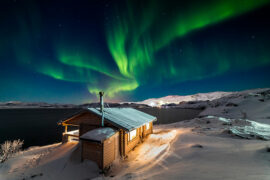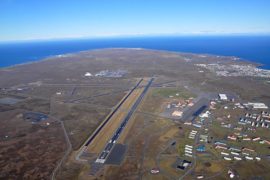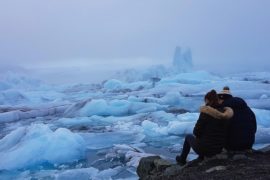The iconic Blue Lagoon is Iceland’s most popular tourist site and attracts some 700,000 visitors a year – almost twice the population of Iceland itself.

The pool’s mineral-rich geo-thermally heated waters are 70 percent seawater and 30 percent freshwater, which are reputed to have therapeutic benefits for the skin and hair.
And let’s face it: swimming around in steamy waters of 37–40°C, surrounded by snow and lava fields, is the Insta shot that everyone wants from a trip to Iceland.
But with increasing crowds, volcanic activity in the area and new alternative pools having opened recently, is the Blue Lagoon still the place to go, or is it overrated?
We look into the cost, the experience and the alternatives to find out if Iceland’s Blue Lagoon is worth visiting.
How much does it cost?
Booking with a third party
What about volcanic eruptions?
Pros and cons of visiting the Blue Lagoon
What to do nearby
Cheaper alternatives to the Blue Lagoon
Is Iceland’s Blue Lagoon worth visiting?
Visiting the Blue Lagoon for less: our top tips
- Reserve an evening or early morning slot if you can – 8am or after 7pm tend to be the cheapest. And in the evening you may even see the northern lights.
- Try and visit on a week day – Saturday and Sunday rates are usually higher.
- Book as far in advance as possible to get the slot you want.
- Book an admission ticket plus transfer together, or combine with a longer guided tour to save money.
- Bring your own costume and robe. Costumes can be rented, but you’ll save money if you bring your own. Towels are included, and robes are included with the Premium package, but if you want a robe, opt for the Comfort package and bring your own.
How much does it cost?
There are several different packages available, plus various treatment and extras that you can add on.
Package prices vary depending on the time of day and the day of the week. Usually mid-day and mid-afternoon at the weekend is the priciest time to visit.
Evening, week-day slots are cheaper, though dynamic pricing is used, so this is not always the case – you can check the website to see which are cheapest slots each day.
| Admission and extras | Price |
| Comfort package | ISK 9,990 |
| Premium package | ISK 12,990 |
| Retreat Spa – five-hour session | ISK 79,000 |
| In-water massage (30 minutes) | ISK 19,900 |
| In-water massage (60 minutes) | ISK 26,900 |
| Salt scrub massage (60 minutes) | ISK 31,900 |
| Salt scrub massage (90 minutes) | ISK 40,900 |
| Float therapy (45 minutes) | ISK 24,900 |
The Comfort and Premium packages
The two basic entrance packages available are Comfort and Premium, both of which include admission to the pool, the sauna, steam room and steam cave, and the use of a towel.

The Comfort Package also includes a Silica mud mask and a drink at the swim-up bar – smoothie, soft drink, beer or wine.
The Premium packages includes three mud masks (a Silica mask, plus a choice of a lava, algae or mineral mask), two drinks at the swim-up bar, plus use of a robe.
The Retreat Spa
For extra privacy, you can pay for access to the exclusive Retreat Spa, which includes admission to the Blue Lagoon, plus a series of smaller private lagoons, surrounded by lava walls, and private changing rooms and outdoor chill-out spaces.

It also includes skincare amenities, a drink and the Blue Lagoon ritual, whereby you cover your skin in silica, algae and minerals for their therapeutic benefits.
Wellness extras
With all the packages, you can add-on several extras such as an in-water massage in a separate massage lagoon, a float-therapy session, or a full-body massage with a Silica salt scrub.
What about booking elsewhere?
Slots on the Blue Lagoon website can get booked out very quickly, so it’s worth looking at third-party booking sites, such as Get Your Guide.
It’s unlikely to be any cheaper than booking direct, but is useful if you want transport from Reykjavik plus admission to the Lagoon together in one package.
Alternatively, you can include a visit here as part of a longer day-trip. We love this tour that ends up at the Blue Lagoon for a relaxing soak after a full-day tour of Iceland’s Golden Circle.
What about volcanic eruptions?
The Blue Lagoon is very close to the site of the recent Sýlingarfell eruption that caused the nearby town of Grindavik to be evacuated and the pool, its hotels and all its facilities to close for a month.

Everything is now open again, but the region is still very seismically active, so further eruptions are possible.
The pool has a very useful page on its website that is updated regularly with all the latest information, including the current risk level, so check here before you book.
The volcanic eruptions of February 2024 blocked the main access road to the Blue Lagoon (the E43), so all traffic is diverted via the coast road and the journey there takes longer than it used to.
Access is now via a longer road which skirts the Reykjanes Peninsula and the town of Grindavik, and only those with a valid Blue Lagoon reservation are allowed past the entry checkpoint.
This means that the journey from the airport now takes 50 minutes, and 80 minutes from central Reykjavik.
The pros and cons of visiting the Blue Lagoon
Ok, so it is a unique place – unlike anywhere else we can think of in the world – but is the Blue Lagoon overrated? And if you come to Iceland but don’t visit this iconic site, will you feel short-changed?
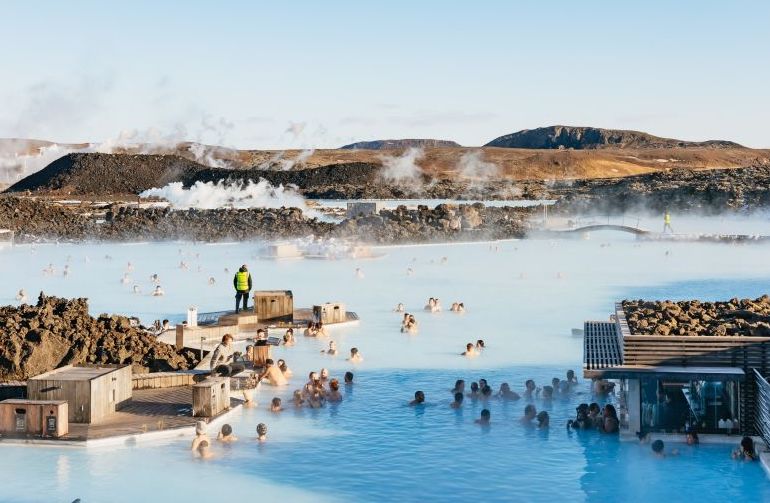
Well, there are definitely pros and cons to visiting the pool. There’s no denying that it’s popular, so gets very crowded.
And we don’t like the fact that because lots of people come here on bus tours of the island, you’ll find a whole load of fellow visitors turning up at the same time.
On the other hand, the pool is large, so the crowds can be absorbed and we think it doesn’t feel too busy once you’re in the water.
And what about the views? If you’ve just seen some carefully curated shots on Instagram and on the official website, you may be surprised to see that behind the Lagoon is a huge geo-thermal plant.
Its distinctive milky blue waters set against a backdrop of snowy mountains and lava fields can look stunning, but only if you screen out the industrial buildings and chimneys of the power plant behind!

And as for the price, is it worth the money? We think that if you can be flexible about when you go and pick one of the cheaper slots, then it’s worth it. The less expensive times are also when it’s quieter, so there’s a double advantage!
We also recommend opting for the cheaper Comfort Package. Unless you’re a big fan of mud masks and think you’ll get really thirsty, there’s no real point in paying extra for the Premium Package.
Pros
- An iconic attraction that you may feel you just can’t miss.
- It’s a relaxing experience that is good for your skin.
- If you pick an evening slot, you may get to see the northern lights from the pool.
- It’s got two on-site luxury hotels and a Michelin-starred restaurant, Moss, attached.
- It’s close to the airport.
Cons
- Can get crowded.
- Can be pricey if you book up a few extras.
- It gets booked up far in advance at busy times.
- You can’t bring your own food or drink in, so if you’re hungry you’ll have to fork out for their pricey snacks.
- It isn’t quite as scenic as the photos make it appear!
- It’s quite far from Reykjavik – the journey from the city centre takes about 80 minutes.
- It’s suffered last-minute closures recently, due to volcanic activity in the vicinity.
What can you do nearby?
Since the Blue Lagoon is close to the airport, people often visit it at the beginning or end of their trip, using a bus transfer directly to the Lagoon from the airport then on the Reykjavik afterwards – (or back to the airport after visiting the Lagoon).
But if you’ve got a bit more time, it’s definitely worth exploring the nearby sites of recent volcanic eruptions and even hiking up a volcano.
However, since the area is still active, you shouldn’t head off on your own – always go with an experienced guide, who will know the latest info about where you can and can’t walk safely.
This tour of volcanos on the Reykjanes Pensinsula takes in the Seltún geothermal area and includes a hike along the Geldingadalur Valley to the Fagradalsfjall Volcano, which erupted in 2021, as well as admission to the Lagoon.
Are there cheaper alternatives to the Blue Lagoon?
Yes, there are. Iceland has plenty of thermal pools and springs where you can swim for free, including the lovely Reykjadalur hot river, where you can hike down a valley and immerse yourself in a river warmed by hot springs.
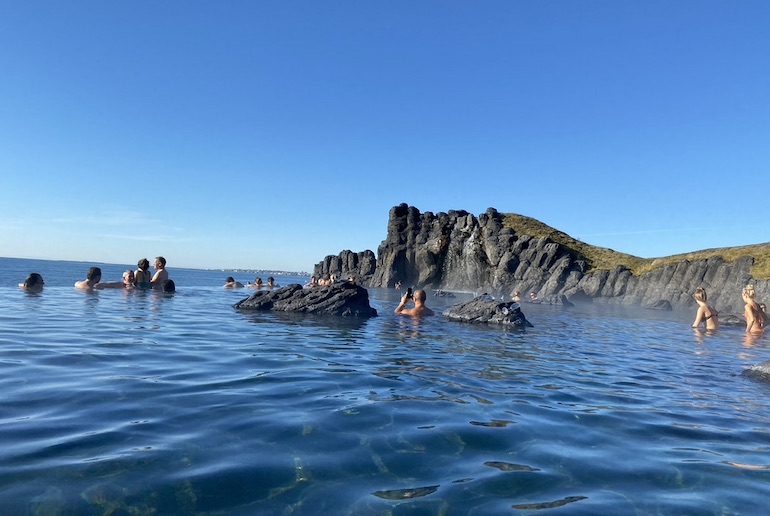
Reykjavik also has a number of municipal thermal pools, where locals go and sit in warm water and socialise. If you don’t mind not having the plush facilities of a luxury spa, they are clean, functional and cheap and a convivial way to spend a Reykjavik evening.
What’s more if you have a Reykjavik Card, admission is completely free. For more on the pros and cons of getting a Reykjavik Card, see out guide to the Reykjavik City Card: is it worth buying?
However, the main rival to the Blue Lagoon is new-kid-on-the-block, the Sky Lagoon.
With beautiful sea views from the pool, a swim-up bar, a seven-step spa ritual and a sauna with a huge glass window looking over the sea, the Sky Lagoon opened in 2021 and is becoming a serious contender for the title of Iceland’s must-visit thermal pool.
It’s cheaper to enter than the Blue Lagoon and closer to Reykjavik – just 15 minutes from the BSI bus station.
If you’ve got your own transport, you can buy tickets admission tickets here, or get tickets with travel from the bus station included.
For more alternatives to the Blue Lagoon, see this guide to the best hot springs in Iceland.
Is Iceland’s Blue Lagoon worth visiting?
So, is it worth the money, or is the Blue Lagoon overrated? In our opinion, it is worth visiting the Blue Lagoon once.
It’s such an iconic site and we think that if you’ve come all the way to Iceland, you’ll feel like you’ve missed out if you don’t visit it.
And despite all the crowds, it was voted 2023’s most relaxing tourist destination by a top spa website.
That said, there are also some really credible alternatives that are definitely worth visiting instead if you’re on a tight budget – or as well, if you fancy a different spa experience.
See also:
Where and when to see puffins in Iceland
Whale watching in Iceland: when, where and how
7 of the best hot spring hotels in Iceland


